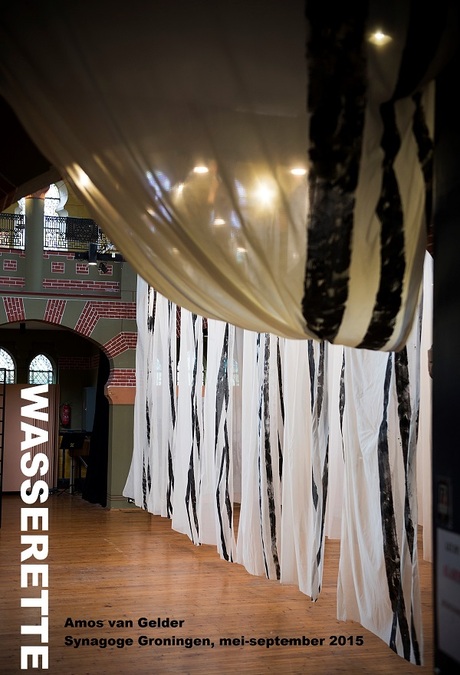Ronit Eden. Concept & Spatial Design offers curatorship and exhibition design
© Ronit Eden. concept & spatial design
Design: Cubicle Design
WASSERETTE
Groningen Synagogue, Groningen, 2015
A site specific installation of Amos van Gelder, curatorship and exhibition design

In the installation Wasserette, life and death are embedded in pieces of cloth suspended in the synagogue. Amidst them, prayer shawls (tallith) burst forth, covering the worshipers gathering in the next hall every Sabbath, as the ghosts of those no longer among us emerge and hover all around. History teems with specters forever wandering amidst the residues from which they were banished, carrying with them memories of culture and memories of spirit. The installation Wasserette invokes these memories from the recent and distant past: how this space once served as a gathering place for a thriving, active community, and how, at the end of war, in a chaotic reality, the synagogue was converted into a laundromat.
First and foremost, however, Wasserette conveys artist Amos van Gelder's personal perspective; his own processing of the tragedy and its underlying absurdity, and their reflection in his life. The installation took shape after van Gelder was exposed to the various metamorphoses of the synagogue, and to the history of the Jewish community and the citizens of the city as a whole.
For van Gelder, Wasserette simultaneously articulates the life imperative of which Etty Hillesum writes in her diary on September 16, 1942:
"I shall live on with that part of the dead that lives forever, and I shall rekindle into life that of the living that is now dead, until there is nothing but life, one great life,
oh God." *
With these words Hillesum willed life and memory to herself and to us as a community. Her legacy reminds us to conjure up the story of the place over and over, in order to construct a history and assume ownership of memory.
As a visitor to Wasserette, your movements become a part of the narrative of the Groningen Synagogue, and your very presence here creates a bridge between private memory and collective memory, rendering it a living moment in the present.
*Etty Hillesum, The Letters and Diaries of Etty Hillesum, 1941-1943, trans. Arnold J. Pomerans (Grand Rapids, Michigan: Wm. B. Eerdmans, 2002), p. 548

















